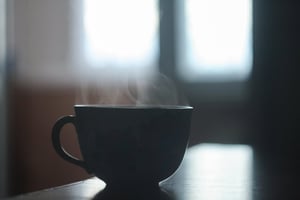Reality Alert: The lunchtime rush was just beginning in a busy toddler classroom at a large childcare center. Teachers were helping children wash their hands and the toddlers were starting to sit down at the table when their food arrived. The cook placed the food on a low shelf next to the table. A child, running over to find her spot at the table, knocked a plate of food off the shelf. Unfortunately the meal included gravy, which was extremely hot. The gravy spilled on the child, resulting in first- and second-degree burns on her neck and chest.
There's a lot of information on this website about severe crockpot burns, but incidents of smaller but still painful burns, like this Reality Alert, happen much more frequently. Children are often burned by hot food and even coffee or tea a teacher leaves within their reach. Even though less skin comes in contact with these hot liquids, these types of burns can be just as severe and cause significant pain for children.
How Hot is Too Hot?

Scalding burns account for 500,000 injuries annually in the United States and children under five are at the highest risk for these burns. According to the Burn Foundation, hot water, at 156 degrees, can cause third-degree burns in just one second. Coffee, tea, soup, and hot water all cause serious scald injuries. This can happen when caregivers aren't paying close enough attention. Many teachers in childcare centers drink coffee or tea while working. Menus often include items like soup or dishes with gravy. Hot water is sometimes used to heat bottles in a mug, similar to using a crockpot. All of these hot liquids pose a burn risk to children.
Preventing Burns
- Let food cool down before serving it or bringing it into classrooms. Children don’t notice if food is a little cool. Serving lukewarm soup or gravy is safer and there’s no need to worry about burns. Also, be sure to stir soups to release any trapped hot spots.
- Anytime food is brought into a classroom, keep it up high and out of reach of children until serving. This is a good idea even if the food isn’t scalding hot.
- Buy infrared thermometers to use on food that’s brought into classrooms. These thermometers are affordable and can quickly display the temperature without having to touch the food/liquid.
- Teachers drinking hot coffee or tea should always have a cover on their drink. Mugs without covers can be very dangerous.
- As with food, coffee or tea should always be kept out of reach of children. Even setting something down near a child for just a minute can result in a burn injury.
- If bottles are warmed using hot water and a mug, keep the mug either in a sink or out of reach of children. Keep in mind that children are likely to reach for their bottles if they can see them. This can be very dangerous if the water in which the bottle is sitting is too hot.




